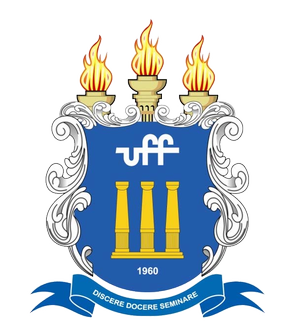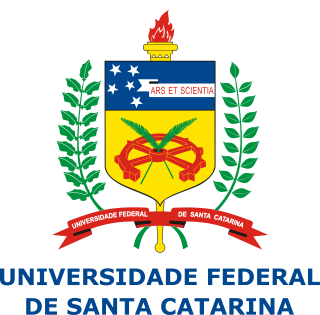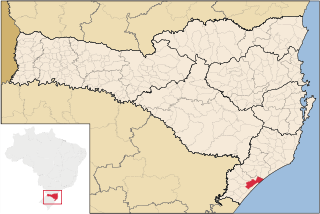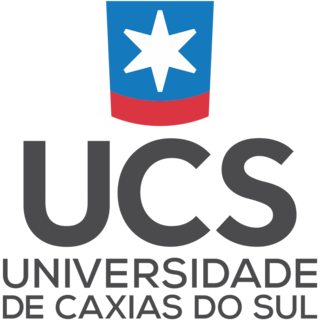
Florianópolis is the capital and second largest city of the state of Santa Catarina, in the South region of Brazil. The city encompasses Santa Catarina Island and surrounding small islands, as well as part of the mainland. It has a population of 508,826, according to the 2020 IBGE population estimate, the second-most populous city in the state, and the 47th in Brazil. The metropolitan area has an estimated population of 1,111,702, the 21st largest in the country. The city is known for having the country's third highest Human Development Index score among all Brazilian cities (0.847).

The Federal University of Minas Gerais is a federal research university located in the state of Minas Gerais. Its main and biggest campus is located in the city of Belo Horizonte, Brazil. It is one of Brazil's five largest and highest-ranked universities, being the largest federal university. It offers 79 undergraduate education programs, upon completion of their curricular schedule the student is awarded either a bachelor's degree, a licenciate degree, or a professional title, all officialized by the issue of a university diploma. It also has 90 postgraduate education programs, awarding 30 postbaccalaureate specialization degrees, 92 master's degrees, and 72 doctoral degrees, as well as 41 medical residency programs offered at UFMG's hospital facilities complexes.

The Fluminense Federal University is a Brazilian public higher education institution located mainly in Niterói and in other cities of Rio de Janeiro state. It was first established on December 18, 1960, with the name of Universidade Federal do Estado do Rio de Janeiro (UFERJ), through an integration of different academic colleges in the city of Niterói. On November 5, 1965, the current name became official.

The Federal University of Rio Grande do Sul is a Brazilian public federal research university based in Porto Alegre, Rio Grande do Sul. UFRGS is among the largest and highest-rated universities in Brazil, having one of the largest number of scientific publications. From 2012 to 2019, the university was elected as the best federal university of Brazil. UFRGS has over 31,000 undergraduate students, over 12,000 graduate students, and more than 2,600 faculty members. As a Brazilian public federal institution, students do not pay tuition fees to enroll in courses offered by the university.

Science and technology in Brazil has entered the international arena in recent decades. The central agency for science and technology in Brazil is the Ministry of Science and Technology, which includes the CNPq and Finep. This ministry also has a direct supervision over the National Institute for Space Research, the National Institute of Amazonian Research, and the National Institute of Technology (Brazil). The ministry is also responsible for the Secretariat for Computer and Automation Policy, which is the successor of the SEI. The Ministry of Science and Technology, which the Sarney government created in March 1985, was headed initially by a person associated with the nationalist ideologies of the past. Although the new minister was able to raise the budget for the science and technology sector, he remained isolated within the government and had no influence on policy making for the economy.

The Federal University of Santa Maria is a Brazilian public university located in Santa Maria, in the state of Rio Grande do Sul, funded by the federal government of Brazil. It was founded in 1960, by Professor José Mariano da Rocha Filho. Its campuses span over 1,837.72 ha, with a total of 386,968 m² of buildings and 28,307 students.

The Federal University of Santa Catarina is a public university in Florianópolis, the capital city of Santa Catarina in southern Brazil.

The Federal University of Viçosa is a Federal University with the main campus located in the city of Viçosa, state of Minas Gerais, Brazil. The university began as the Higher College of Agriculture and Veterinary Science created in 1922 but with classes only beginning in 1927. In 1948 it was transformed into the Rural University of Minas Gerais. It was federalized in 1969 with its present name.

Joinville is the largest city in Santa Catarina, in the Southern Region of Brazil. It is the third largest municipality in the southern region of Brazil, after the much larger state capitals of Curitiba and Porto Alegre. Joinville is also a major industrial, financial and commerce center.

Araranguá is a city located in the southern part of Santa Catarina state, in the south of Brazil. It has 68,867 inhabitants and was settled mainly by Portuguese and Italians. Araranguá is known as "A Cidade das Avenidas" because of its wide roads.

The Federal University of Rio Grande do Norte is a public Brazilian university funded by the Brazilian federal government, located in the city of Natal, Rio Grande do Norte, Brazil.

The Federal University of Technology – Paraná is a federal university with campuses in thirteen cities located in the state of Paraná.

The University of Caxias do Sul is a higher education institution in the northeast region of Rio Grande do Sul, Brazil. It has units in the cities of Caxias do Sul, Bento Gonçalves, Vacaria, Canela, Farroupilha, Guaporé, Nova Prata and São Sebastião do Caí, offering more than 150 admission options in nine different areas of knowledge. In 2017 and 2018 it was listed by the university ranking of Folha de S. Paulo as the sixth best private university in the country.

The Federal Institute of São Paulo, or in full: Federal Institute of Education, Science and Technology of São Paulo is an institution that offers high education and professional education by having a pluricurricular form. It is a multicampi institution, specializing in offering professional and technological education in different areas of knowledge. It was known previously as Federal Center of Technological Education of São Paulo. IFSP is one of the five Federal Colleges in São Paulo, the other ones being ITA, UFSCar, UNIFESP and UFABC.

The Universidade Feevale (Feevale) is a Brazilian university in the city of Novo Hamburgo in the metropolitan region of Porto Alegre, Rio Grande do Sul. The selection process is through entrance exam and continuous assessment.
The University of the State of Paraná is an institution of higher education administered by the Government of the state of Paraná, with a headquartered in the city of Paranavaí, It has campuses in the cities of Curitiba, Apucarana, Campo Mourão, Paranaguá, Paranavaí, São José dos Pinhais and União da Vitória, created by State Law nº 13.283, on October 25, 2001, changed by State law nº 13.358 on December 21, 2001, State Law nº 15.300 on September 28, 2006, and by State Law nº 17.590 on June 12, 2013. It is affiliated with the Science, Technology and Higher Education's Secretary of State.

The Federal University of Pará is one of the three public universities maintained by the Brazilian federal government in the state of Pará. It was ranked as the 15th largest Brazilian university in a 2011 academic ranking by the number of enrollments. The university has over 60,000 students enrolled in its courses, which are offered across its many campuses in the cities of Belém, Abaetetuba, Altamira, Ananindeua, Bragança, Castanhal, Cametá, Capanema, Breves, Tucuruí and Soure. Among UFPA research teams, there are many nationally recognized groups, particularly in the fields of genetics, parasitology, tropical diseases and geosciences. The Federal University of Pará is the largest institution in the North region of Brazil by enrollment and is a reference in the areas of Biomedical Sciences and Biology research, this last one mainly because of the Amazon Rainforest.
The Federal University of Alfenas is a public institution of undergraduate and postgraduate education situated in Alfenas and having campuses in the cities of Poços de Caldas and Varginha, all in the southern region of the Brazilian state of Minas Gerais.

The Federal Institute of Brasília, or in full: Federal Institute of Education, Science and Technology of Brasília is an Institute of Technology located at the capital of Brazil that offers different types of degrees and operating often at variable levels of the educational system. It is an institution of Higher education and professional vocational education, specializing in science, engineering, and technology or different sorts of technical subjects. It is also a secondary education school focused on vocational training and applied Scientific research.

















